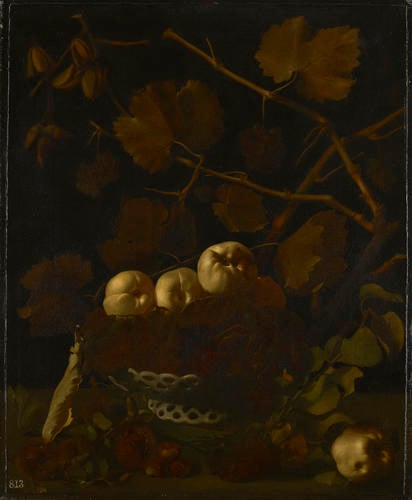Still Life with Quinces and Acorns c.1625-33
Oil on canvas | 86.2 x 71 x 2 cm (support, canvas/panel/stretcher external) | RCIN 402559
-
The Spanish painter Juan Fernández was known as El Labrador owing to his preference for living in the country and coming only occasionally to Madrid. His known output principally consisted of small canvases and panels of fruit and flower still-lifes. Of approximately twenty still-lifes referred to in documentary sources, only a few can be identified today. El Labrador’s still-lifes were enthusiastically sought by aristocratic collectors in Madrid in the 1630s, while his works were introduced to England by English diplomats at the Spanish court, in particular by Lord Cottington, a prominent pro-Spanish courtier who served as English ambassador to Spain under both James I and VI and Charles I, and by his secretary Sir Arthur Hopton. In 1635, the latter commissioned the artist's first flower painting. The resulting small panel of a Vase of Flowers (1636; priv. col. see Spanish Still-life in the Golden Age, 1600–1650, W. B. Jordan, Fort Worth, Kimbell A. Mus., 1985) is the artist’s only signed work and records his true name. In the early 1630s Giovanni Battista Crescenzi offered Charles I four landscapes by El Labrador that were on sale in Madrid; this is the only reference to El Labrador’s work in this genre.
Still-life with Quinces and Acorns was given to Charles I by Lord Cottington and was first recorded in the Royal Collection by Van der Doort in the 1639 inventory of the King's collection (No.13). The dramatic directional lighting, smooth chiaroscuro and horror vacui are characteristic of El Labrador's known works and demonstrate the indirect influence of Caravaggio. Labrador appears to have concertedly avoided the impression of artifice created by the symmetry, perspective and geometric shapes of contemporary still lifes by artists working in the Northern strain, such as Juan van der Hamen. The dry, curled leaf on the left of the composition and the imperfection of the worm-eaten quince on the far right are definite Caravaggesque traits; however, the brilliant illumination of forms against the utter darkness is closer to the light seen in Caravaggio's mature religious works than it is to the pure, even light of his early still life paintings. As William B. Jordon has commented, El Labrador's style 'represents a personal and even eccentric adaptation of the general features of Caravaggio's that could understandably have developed far from the master's coterie in Rome, but under what stimulus we do not know.' (William B Jordan, Spanish Still Life in the Golden Age 1600-1650, Kimbell Art Mus., Fort Worth: 1985, p.155)Like other paintings attributed to the artist, the picture has suffered from the extensive darkening of certain pigments due to a fault in the artist's technique; nevertheless, the delicate chiaroscuro and muted colours justify the extravagant praise accorded El Labrador for generations after his death.
Provenance
Presumably acquired by Charles I; recorded in the Cabinet Room at Whitehall in 1639 (no 13); sold for £44 to Jan Baptiste Gaspars on 22 March 1650 from St James's Palace (no 115); recovered at the Restoration and listed in the King's Closet at Whitehall in 1666 (no 322)
-
Medium and techniques
Oil on canvas
Measurements
86.2 x 71 x 2 cm (support, canvas/panel/stretcher external)
97.7 x 82.7 x 7.2 cm (frame, external)
Category
Object type(s)
Alternative title(s)
Still life with apples in a dish, traditionally entitled








